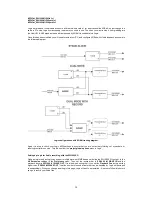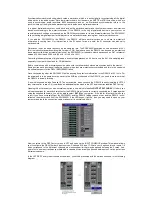
40
Wave Device
SW1000#1 Wave OUT – Audio 1
SW1000#2 Wave OUT – Audio 2
SW1000#3 Wave OUT – Audio 3
SW1000#4 Wave OUT – Audio 4
SW1000#5 Wave OUT – Audio 5
SW1000#6 Wave OUT – Audio 6
This would set up your MME wave ports for multi-channel support. Then when you record your tracks and go to
playback, you should find that instead of having to use the CPU intensive mixer of your multitrack application, you
can actually use the mixer in XGEDIT to control volume levels. This also applies to panning and effects sends, much
in the same way as we have discussed in the previous chapters.
Once you are happy with your mix and effects settings, you can then use the
SW1000#2
Wave record option
(loopback) to make a stereo mix of the tracks, either to free up your effects for more tracks, or to make a final mix for
pressing to CD.
With stereo wave editing software such as WaveLab or SoundForge, the problem of adding permanent effects is
more unique. Whilst you have the ability to use any of the wave ports for playback, and can also use the 2 options for
recording (with or without effects being added to hard disk), it is impossible to add effects at a later date and then
print them to the wave file. As you only have the ability to playback or record to a single stereo file, and not really at
the same time. (This is the nature of the way that stereo wave editing software works!).
You could however if you have access to one, create your final stereo master with the SW1000XG effects, and then
digitally stream it to a DAT or minidisc style of recorder. This is not ideal, as it defeats one of the SW1000XG’s
strongest capabilities, that being its ability to create a stereo master internally using the loopback option.
Now may be a good time to run up XGWorks? In XGWorks you could import your wave file created in your stereo
editor, add the effects, loopback re-record it to a new wave file, and then paste that back into your stereo editor of
choice.
The same problem manifests itself when using software synths, although you could always assign the playback from
the software synth to for example
SW1000#1 wave out
. Then set your stereo audio recorder or multitrack audio
recorder to record from the
SW1000#2
wave record buss (loopback). Then set your stereo editing software to
playback on
SW1000#2
wave playback. This would make it possible to capture the audio from the software synth into
your audio editor, and then play it back from there without having to re assign audio ports.
This way you could easily add effects to any software synth without having to use any additional CPU power (You
could always get into the PLG concept which wont use any CPU power at all, and can give you a whole new synth for
less than many software synths cost). This is covered in more detail in the next chapter.
For Audio & MIDI sequencers that we have not yet covered, the rules that apply to VST are a good place to start, but
just in case you have skipped the VST chapter I shall re-summarise.
















































